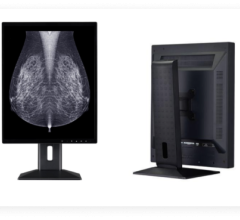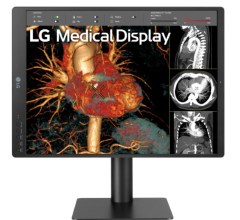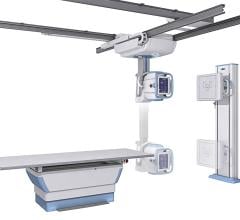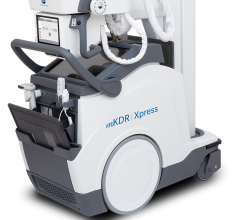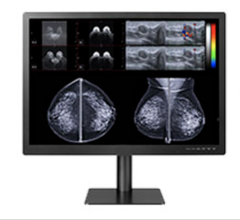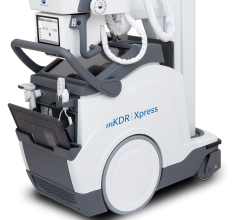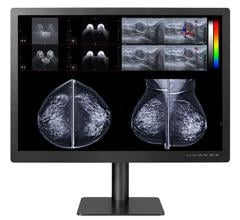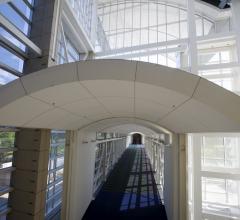
May 24, 2011 – The new RadiForce RX430 monitor can simultaneously display color and monochrome images with separate gamma curves. The 29.8-inch monitor was originally featured at RSNA 2010, and mass production was scheduled for January 2011. Availability varies by country.
The RX430 features a hybrid gamma function that enables it to simultaneously display monochrome and color images with their own gamma curves. Hybrid gamma automatically distinguishes whether the displayed images are monochrome or color, even within the same application. It displays the monochrome images in DICOM Part 14 adjusted mode and the color images in gamma 2.2 adjusted mode. These and other modes are user-selectable. This expands the usability of picture archiving and communication system (PACS) applications by ensuring that color and monochrome medical images are optimally displayed.
The screen size and native resolution of 4 megapixels (2,560 x 1,600) for a 16:10 widescreen format give this monitor the same amount of screen size and number of pixels as two 2 megapixel monitors in portrait mode, but without the obtrusive bezels. This simplifies comparing images or allows for showing more information within one screen. The RadiForce RX430 utilizes a new in-plane switching (IPS) panel with almost no noticeable color shift when viewing the screen from oblique angles. It offers a maximum brightness of 1,000 cd/m² and 1,100:1 contrast ratio. This figure is on a par with monochrome monitors, making the RX430 suitable for displaying both 3-D rendering and fusion color images and computed tomography (CT) and magnetic resonance imaging (MRI) monochrome images compliant with the DICOM Part 14 standard.
Like all RadiForce diagnostic monitors, the grayscale tones for each RadiForce RX430 unit are adjusted at the factory to comply with DICOM Part 14. Furthermore, they are calibration-compliant with the DICOM Part 14 to ensure continuing monitor quality control. The RadiForce RX430 supports an Integrated Front Sensor housed within the front bezel to provide independent verification measurement of the grayscale tones and to perform calibration compliant to DICOM Part 14.
By installing the bundled RadiCS LE software, the Integrated Front Sensor and RadiCS SelfQC function allows QC tasks to be performed by the monitor itself even when the connected workstation is switched off. The company says this dramatically cuts monitor quality control workload and maintenance costs. It also comes with an integrated presence sensor that offers convenience and energy savings. The presence sensor will prompt the monitor to switch to power save mode when it detects the user is away from the monitor and then resume normal operation when the user returns.
Furthermore, the sensor determines whether to start QC tasks, such as calibration, at scheduled times. If the user is working, the task stays in stand-by mode, and when the user is away from the monitor the task is performed.
The RadiForce RX430 also can be used for viewing images in operating rooms. To meet the need of different operating room (OR) environments, this monitor is available in two model configurations: a standard configuration that comes with a stand but without a panel protector, and a free-mount (no stand) configuration that comes with a panel protector and offers easy attachment to ceiling suspensions. Its sealed cabinet design with no ventilation holes on top is suitable for safe and clean integration in the OR.
The free-mount model with a panel protector is IPx2-rated to protect against ingress by dripping water. With the CAL switch function, the grayscale tones and brightness settings are stored directly in the monitor, allowing one to easily adapt to different modality images, such as computed radiography (CR), CT and endoscopy by selecting the desired modes through the button on the front bezel. The RX430 includes text mode for clinical records, sRGB mode for endoscopy, hybrid gamma mode for hybrid display of monochrome and color images, and five variant calibration modes for convenience that eliminate the need to perform calibration each time a new grayscale and brightness setting is required.
For more information: www.eizo.com

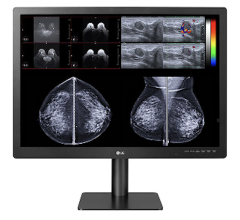
 March 12, 2024
March 12, 2024 
